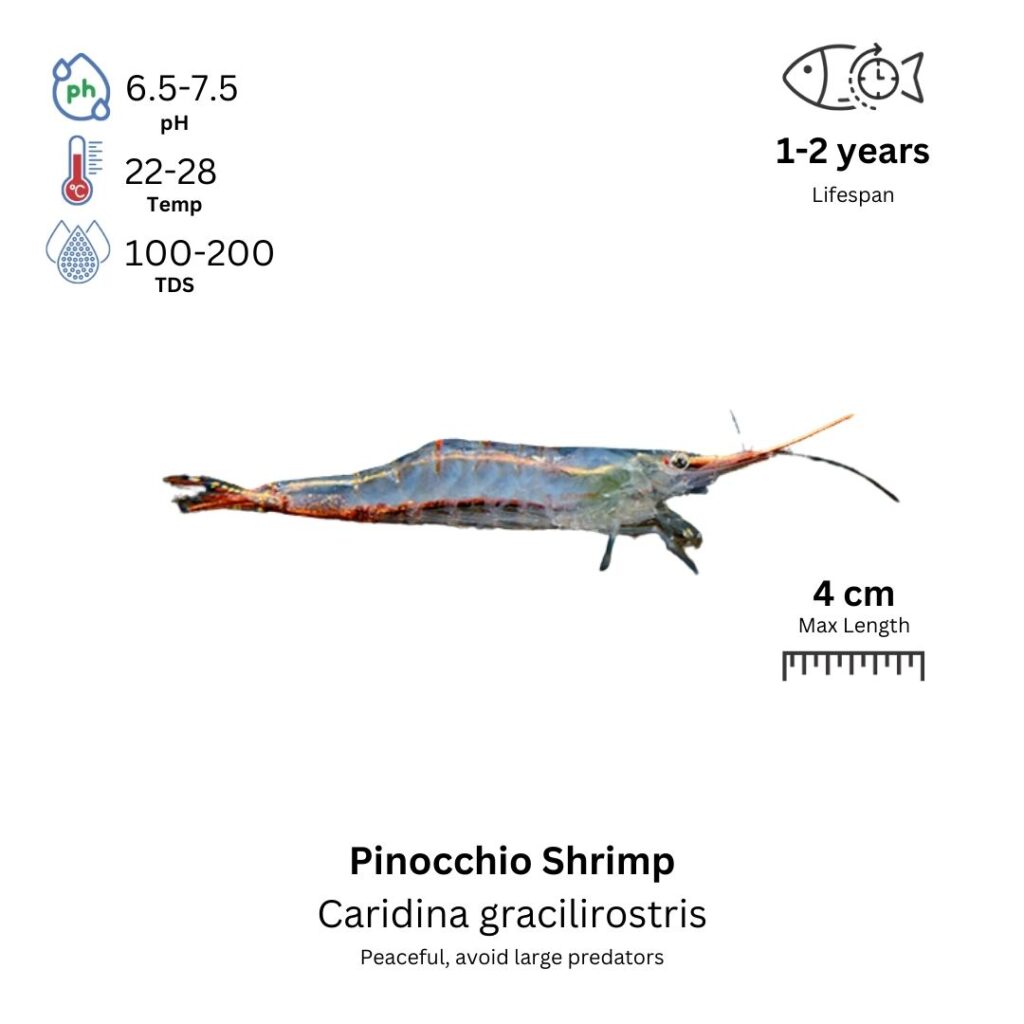Pinocchio Shrimp
Caridina cf. cantonensis

Description
The Pinocchio Shrimp is a small, transparent shrimp known for its long, distinctive rostrum (snout), which gives it a “Pinocchio-like” appearance. The rostrum extends well beyond the shrimp’s body, making it one of the most unique features of the species. The body is usually translucent with a slightly reddish or brownish tint, and the shrimp’s legs and antennae are long and slender. This transparency provides them with excellent camouflage in natural environments, making them less noticeable to predators. Pinocchio Shrimp are peaceful, active, and social creatures, often found scavenging for food along the substrate or grazing on algae. They are excellent at cleaning up leftover food and organic matter in the tank, making them beneficial for aquarium maintenance.
Habitat Origin
Native to the coastal waters of the Indo-Pacific region, particularly in areas like the Philippines, Indonesia, and parts of the Pacific Ocean. They are commonly found in shallow waters with sandy or muddy substrates, often hiding among rocks, plants, and debris. These shrimp prefer clean, well-oxygenated water and tend to inhabit environments with slow-moving currents and plenty of hiding spots.
Aquarium
Ideal Number in Aquarium: At least 3-5 individuals, as they are social creatures and feel more comfortable in groups.
Favorite Food

Pinocchio Shrimp are omnivores and will eat a variety of foods. They primarily feed on algae, detritus, and small organic matter they find in the aquarium. In captivity, they can be fed high-quality shrimp pellets, sinking algae wafers, and live or frozen foods like brine shrimp, daphnia, and bloodworms. They are also excellent at scavenging leftover food from other tankmates, helping to maintain a cleaner environment.
Behavior:
Pinocchio Shrimp are peaceful, calm, and active creatures that spend most of their time near the bottom of the tank, searching for food. They are nocturnal to some extent but will often be seen during the day as well, especially in tanks with plenty of hiding places. They are not aggressive and are safe to keep with most peaceful species, such as small fish, other shrimp, and snails. However, larger or aggressive fish may pose a threat to them. They are also known for their cleaning behavior, as they help control algae growth and keep the tank tidy.
Special Care:
Pinocchio Shrimp are relatively low-maintenance but require stable water conditions to thrive. They prefer clean, well-filtered water with stable pH and temperature levels. It’s important to avoid using copper-based medications in tanks containing these shrimp, as copper is toxic to them. They are also sensitive to drastic changes in water conditions, so regular water changes and maintaining good filtration are important. The tank should have plenty of hiding spots, such as plants, rocks, or other decorations, to provide them with shelter and make them feel secure.
Compatibility with Other Fish:
Yes, Pinocchio Shrimp are compatible with many peaceful species. They can be kept with small fish like tetras, guppies, and rasboras, as well as other non-aggressive shrimp and snails. However, they should not be kept with larger or more aggressive fish that may view them as food. They are particularly well-suited for planted aquariums, as the plants provide both food sources (in the form of algae and biofilm) and hiding places.
Breeding Setup
Although Pinocchio Shrimp can breed in community aquariums, using a separate breeding tank is strongly recommended for better water parameter control and fry survival. A 20-liter (5-gallon) tank is ideal for a small group. Maintain pH 6.5–7.5, temperature between 24–28°C, and GH 4–10 dGH. Use a sponge filter with gentle flow to avoid disturbing the shrimp. Add fine substrate, Java moss, Anubias, and driftwood to simulate their natural habitat and offer egg-laying and hiding surfaces. Keep lighting moderate to low to reduce stress.
Conditioning for Breeding
Condition the shrimp with a balanced omnivorous diet, including shrimp pellets, blanched vegetables (zucchini, spinach), algae wafers, spirulina, and live foods such as daphnia or baby brine shrimp. A diverse, nutritious menu helps females produce more viable eggs. Perform weekly 25% water changes with dechlorinated, stable-temperature water to support a clean and breeding-friendly environment.
Spawning Process
Spawning occurs when water conditions are optimal. Mating is preceded by courtship, where the male chases the female and fertilizes her eggs. The female carries 30–50 eggs in a visible greenish or yellow cluster under her abdomen (saddle). She will fan the eggs with her pleopods to oxygenate them until hatching. It is best not to disturb the female during this incubation period of 2–3 weeks.
Fry Care
Once hatched, the fry remain near the mother briefly before becoming independent. Their first food includes biofilm and microalgae. Supplement with infusoria, liquid fry food, or powdered algae. After a few days, introduce baby brine shrimp or finely crushed flakes. Perform daily 10–15% water changes, maintaining a temperature of 24–28°C and avoiding spikes in ammonia or nitrite. Good water quality and stability are crucial for fry survival.
Important Notes
Pinocchio Shrimp reach sexual maturity at 4–6 months. Females are larger and rounder, especially when berried (carrying eggs), while males are slimmer and more active during courtship. To avoid stress, keep a peaceful tank, avoid aggressive tankmates, and ensure stable parameters. A low-stress environment leads to higher breeding success and better fry development.
